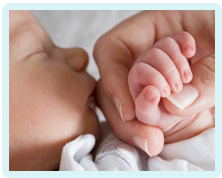
Can Having An Episiotomy Reduce The Chance Of A Third Degree Tear?
The idea of being cut in the area of the vagina or anus is enough to make even the strongest woman feel squeamish. In fact, for many expectant mothers, the prospect of an episiotomy is extremely frightening.
There are some suggestions that an episiotomy can reduce the risk of tearing during labour. But is this true? Or does it increase the likelihood of a mother suffering a severe third or fourth degree tear.
The unkindest cut
Episiotomies are not unusual. In fact, the first record of an episiotomy dates from 1742 and the first published account of the procedure in a medical journal was in 1810. They became extremely popular in the 20th century; between 1940 and 1980 episiotomies became routine in the US and, to a lesser extent, in the United Kingdom.
Widespread use of episiotomy was promoted as better facilitating the birth, protecting the baby's head from trauma and preventing lacerations of the perineum and undue stretching of the pelvic floor. Doctors also believed that a clean downward cut on the labouring woman's perineum was safer for the baby and better for the mother than letting a woman's perineum tear during pushing. A straight cut was easier to stitch than a jagged tear, and doctors argued that a woman would feel less postpartum pain and have fewer future problems with pelvic-floor complications (like urinary incontinence).
However, a number of studies were done in the 1980s which highlighted the trauma women suffered when given what was often an unnecessary episiotomy. A 1984 paper concluded that there was no benefit from the practice of routine episiotomy.
The number of episiotomies in England has declined over the last few decades, decreasing from 51% in 1975 to 15% in 2010-11, (note - this is only an approximate comparison because the statistical methodology used changed in 2006).
Do episiotomies prevent tearing?
An episiotomy is performed by making an incision and cut in the perineum — the tissue between the vaginal opening and the anus — during childbirth. There are two main types of episiotomies – the midline and the mediolateral. The midline is when the doctor makes the incision straight down towards the anus, and the mediolateral is an incision made diagonally to help avoid a later tear into the anal area.
In the UK it is negligent for a midwife or doctor to perform a midline episiotomy.
Recovery can be uncomfortable, and sometimes an episiotomy results in more stitches than a natural tear. Infection is possible. In rare cases, an extensive episiotomy might also contribute to faecal incontinence after childbirth.
During the 1990s, further in-depth studies began to point to the opposite of what doctors in the 1950s-80s believed. Researchers found that episiotomies are actually associated with more postoperative pain, a much greater likelihood of tears in the anus (ouch), and other complications. One study showed that women who had episiotomies were as much as six times more likely to report faecal or flatus (gas) incontinence than women who delivered with an intact perineum.
Studies also show that an episiotomy may be associated with a greater chance of a woman receiving a third or fourth degree tear.
A more natural way to prevent third degree tears
Many midwives believe that there are more natural ways to prevent tearing in childbirth, including:
- good nutrition during pregnancy
- perineal massage
- Kegel exercises
- controlled pushing
- warm compresses placed on the perineum during labour
Episiotomies should only be performed if medically necessary
The evidence as to whether an episiotomy can prevent tearing during childbirth is conflicting and more research needs to be done. However, women need to be more informed about tearing and episiotomies before they give birth, so they can make an informed decision about how they want their labour to progress if an episiotomy is suggested.
For an expectant mother who believes she has had an unnecessary episiotomy performed, or has suffered from a third degree tear due to negligence, compensation can help pay for treatment, loss of earnings and make up for the pain such an injury can cause.
At Glynns Solicitors we have the expertise required to successfully act for women who have received a third-degree tear caused by medical negligence.
Making an Enquiry
Please call us on 0800 234 3300 (or from a mobile 01275 334030) or complete our Online Enquiry Form.



